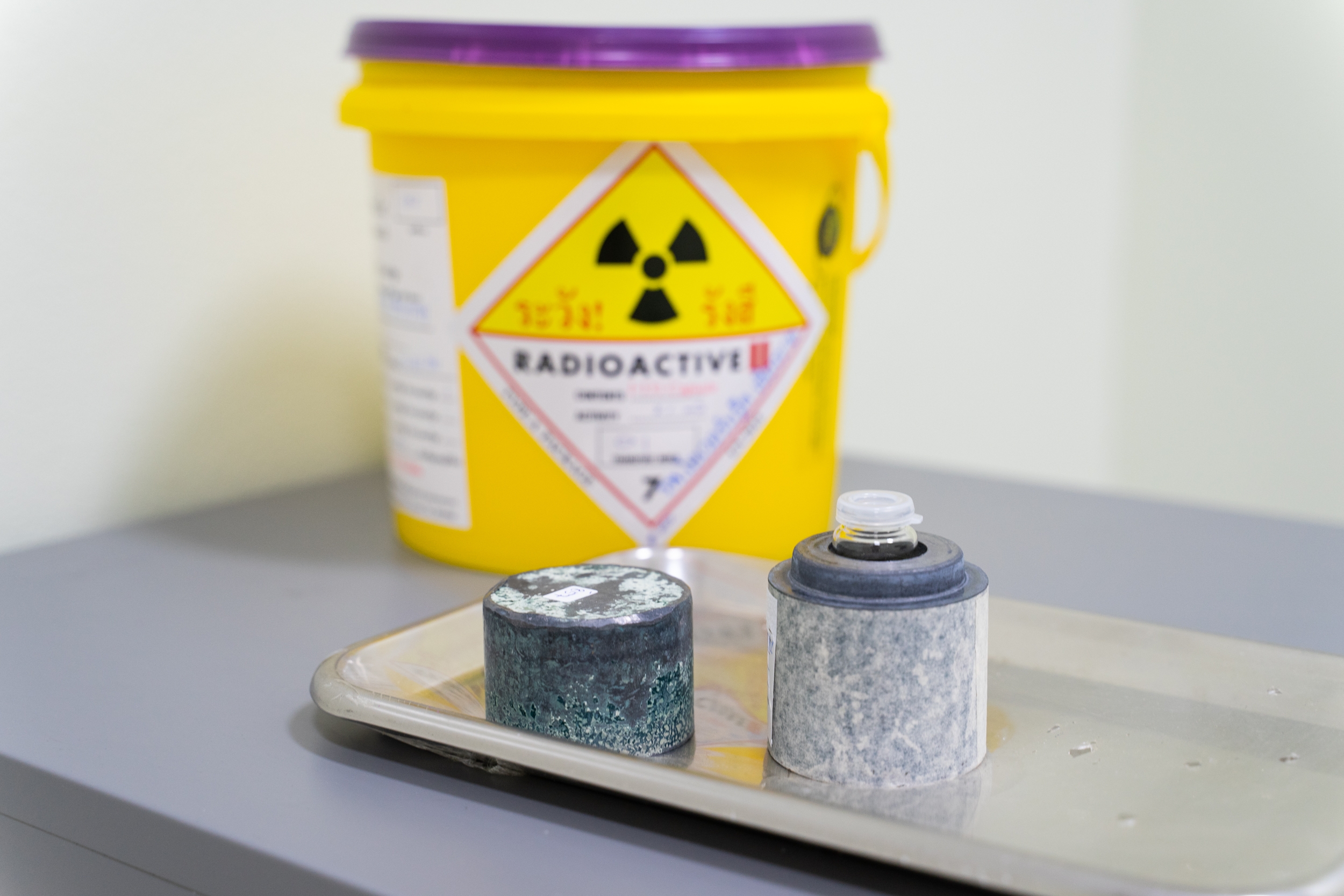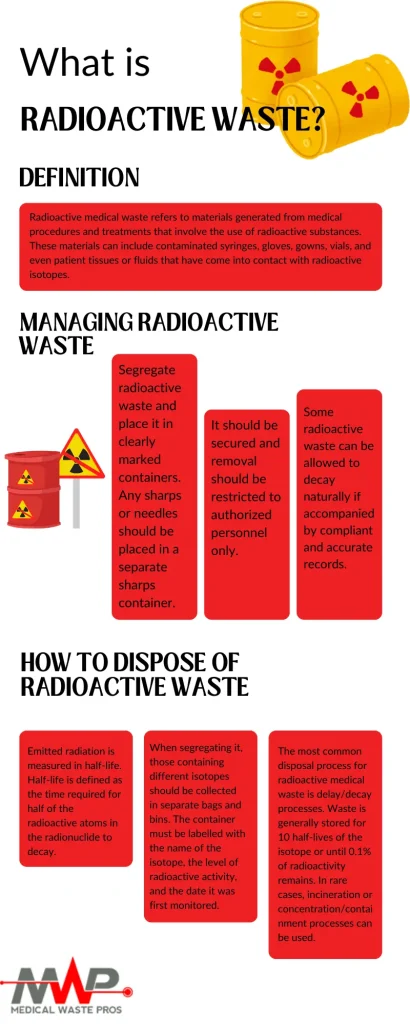What is Radioactive Waste & How Do You Dispose of It?

When we hear the word “radioactive,” many of us think of nuclear plants or sci-fi movies. However, radioactive waste is actually a common byproduct of many everyday industries. From medical treatments to scientific research, radioactive waste exists in more environments than you might think.
This waste, if not properly managed, can pose serious risks to both human health and the environment. In this blog post, we’ll dive into what radioactive waste is, the different types that exist, and the steps needed to handle and dispose of it safely.
What is Radioactive Waste?

Radioactive waste is considered any material containing unstable atoms that give off energy as they decay. This type of waste is created across many sectors, including medical, industrial, and scientific fields. It can range from low-level items like contaminated gloves to high-level waste via nuclear reactors. Each type of radioactive waste requires different handling methods to keep radiation exposure to a minimum and protect public health and the environment.
Types of Radioactive Waste
Understanding the types of radioactive waste is essential to knowing how to handle each one safely. Each type has unique regulations and requirements for handling, storing, and disposal. Here’s a quick breakdown:
- Low-level waste (LLW): This includes items contaminated with small amounts of radioactivity, like clothing, filters, and medical syringes. LLW usually doesn’t require heavy shielding and can sometimes be allowed to decay naturally.
- Intermediate-level waste (ILW): ILW contains higher levels of radiation and often requires shielding during handling and transport. Examples include reactor components and some industrial waste.
- High-level waste (HLW): Generated mostly from nuclear reactors, HLW is highly radioactive and must be stored securely, often in shielded facilities, for long periods. It includes spent nuclear fuel and byproducts from nuclear power generation.
- Medical radioactive waste: This specific subset of radioactive waste comes from hospitals and research labs and includes contaminated syringes, vials, and patient materials exposed to radioactive treatments. The Environmental Protection Agency typically considers radioactive medical waste to be low-level waste.
When & How People Come Into Contact with Radioactive Waste
While the idea of radioactive waste might sound a bit removed from the day-to-day, people can encounter it in various everyday settings. From medical treatments to industrial processes, radioactive materials play a role in fields that touch our daily lives. Here’s an overview of how individuals might come into contact with different types of radioactive waste.
Medical Settings
Patients receiving treatment can be exposed to radioactive waste Radioactive materials are often used in treatments like cancer therapy (radiotherapy) and diagnostic imaging (think positron emission tomography, or PET, scans). After these procedures, patients may carry traces of radioactive substances for a short time. Those visiting patients, like family and friends, may also have brief, minimal exposure.
Nurses, doctors, and radiologists may work with radioactive materials when treating patients. Medical staff handling contaminated materials while cleaning up are also exposed to low-level radioactive waste. Proper protective gear and disposal procedures are essential to keep exposure minimal.
Scientific & Research Laboratories
In scientific labs, radioactive isotopes are used in experiments, medical research, and pharmaceutical development. Researchers and lab technicians working with these materials handle low- to intermediate-level radioactive waste daily. This waste can include contaminated gloves, vials, and equipment used in experiments.
Some academic institutions use small amounts of radioactive materials for educational purposes, especially in fields like physics or chemistry. In these cases, students and instructors may come into contact with very low-level radioactive materials, typically under controlled conditions.
Public Exposure from Contaminated Items
Occasionally, radioactive materials can be present in consumer products. For instance, items like smoke detectors use small amounts of radioactive materials (usually very low-level waste that is contained and safe). Improper recycling or disposal of these items could potentially lead to low-level radioactive waste entering landfills.
People may also be exposed to low levels of radioactive waste through environmental sources. Things like contaminated groundwater near disposal sites or old mines can be especially risky if waste disposal standards were not properly followed.
Best Practices for Handling Radioactive Waste
Handling radioactive waste safely is crucial to prevent contamination. Here are some key steps for handling any kind of radioactive waste:
- Segregate and label it properly. Sort waste by type and radioactive isotope, placing it in designated containers clearly marked with isotope names, activity levels, and monitoring dates.
- Use protective equipment. Always wear protective gear like gloves, gowns, and eye protection to reduce exposure to radiation.
- Restrict access. Only authorized personnel should handle or access radioactive waste areas.
- Document and monitor. Keep accurate records of all waste, including dates, amounts, and radiation levels, to track decay and ensure compliance with regulatory standards.
Safe Disposal of Radioactive Waste
Disposing of radioactive waste requires careful planning and, often, expert assistance. Disposal methods vary depending on the type and level of radioactivity:
- Decay storage: For short-lived waste, allowing it to naturally decay in secure storage is often the preferred method.
- Specialized disposal facilities: Long-lived waste may need to be transported to designated facilities that can safely contain it for decades.
- Incineration: In rare cases, some radioactive waste can be incinerated to reduce its volume. However, this is only done under strict regulatory control.
- Containment and sequestration: For materials that can’t decay quickly, waste is stored in secure containers designed to prevent leaks and contamination over long periods of time.
Rely on Medical Waste Pros for Radioactive Waste Disposal
Handling radioactive waste can be complex. That’s why it’s best left to professionals. Medical Waste Pros offers reliable solutions for managing medical radioactive waste safely, helping facilities comply with all safety standards and regulations.
With years of experience in waste management, Medical Waste Pros stays up-to-date with regulatory changes and safety practices, giving you peace of mind. We’ll help you develop a plan tailored to the specific needs of your facility so safe handling and disposal procedures fit seamlessly into your operations.
What’s more, Medical Waste Pros offers prompt service to manage waste on your schedule, whether you need routine pick-ups or a one-time disposal service. Their affordable services mean that even complex waste management can fit within your budget, saving you the time and resources of handling it in-house.
By working with Medical Waste Pros, you gain not only a service provider but a partner dedicated to ensuring safety, compliance, and peace of mind. Call us at (888) 755-6370 and learn how we can simplify your radioactive waste disposal process and keep your environment — and your team — protected.










